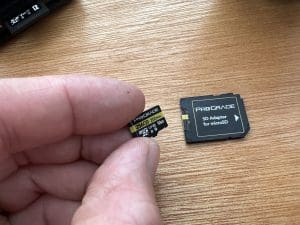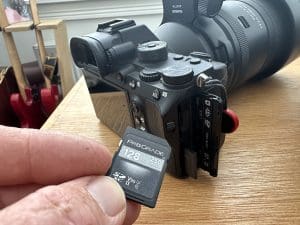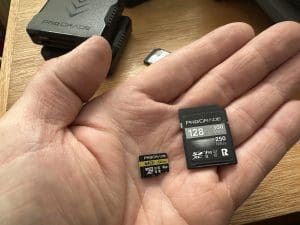What are TF cards?
TF cards are little tiny cards that store various digital formats, mostly images, and movie files when used with devices like cameras, drones, and video cameras. You will also find TF cards mostly called Micro SD cards these days. These cards are only about 1mm thick and measure 11x15mm
TF cards come in many storage sizes, typically starting at about 32 GB these days and spanning all the way to 1 TB - 1 TB in such a tiny card is truly mind-boggling! I should add that it is possible to find MicroSD cards all the way up to 2 TB, but these are from brands I’ve never heard of, and having spent the last 20 years in the photo industry, I’m a little wary of memory cards from brands I’ve not heard of.

TF (later MicroSD, so let’s just call them that now) was originally billed as the card of choice as they were built specifically small for use with mobile phones to expand the manufacturer's installed memory. Most telephone manufacturers stopped adding MicroSD slots to their devices around 2015, but the format didn’t fade away, it grew with use in compact HD cameras in the rise.
They come in a couple of different flavors, most typically the MicroSDHC - Micro SDHC stands for Secure Digital High Capacity. These little cards can contain between 2GB and 32GB of data, and MicroSDXC - Micro SDXC refers to Micro Secure Digital extreme Capacity. These cards can hold between 32GB and 2TB. Drones, GoPro, 360 or VR cameras, and other content-creating devices commonly use MicroSDXC cards for capturing and storing footage.
Some of the benefits of the MicroSD range of cards aside from being absolutely tiny, are that they are close to indestructible! They don’t mind getting squashed (let’s not go running over them with a car, but compared with an SD card or a CF card, they’re very robust!) I have found cheaper MicroSD cards can be a little brittle, but as my mother always says - you get what you pay for! They will happily operate from about -10c and right up to 70c (obviously best to check with the manufacturer to make sure!) and they can be stored in -20c cold and 80c heat (no thank you!) They use very little power for operation, so they won’t have that much of a drain on your devices while in use.
Something to note is that with an SD card adapter (typically given to you in the package when you purchase a MicroSD card) you can use your MicroSD card in any device that takes SD cards!
What are SD Cards?
Just like the TF or MicroSD memory card, the SD cards are primarily the same, a memory card that comes in varying sizes all the way up to 2 TB, but it’s a different form factor to its smaller cousin. The SD card, often called SD, SDHC, or SDXC card are all the same physical size, but they can be up to 2 GB for the regular SD format, while the SDHC format allows you from 4 GB up to 32 GB and then the SDXC extends from 64 GB all the way up to 2 TB! They also have different speed ratings, mostly marked with a 4, 6, or 10, which refers to the slowest speed at which the card is rated to continuously write data, so 4, 6, or 10MB/s the read speed, how fast the card can take your data onboard when you hit record or release the shutter on your camera, is listed differently. Typically a U with a number in it.

The numbers 1 to 3 within the letter U refer to a U1 or U3 speed rating. U1 is the same as Class 10 and means that a card is designed to write at a minimum of 10 MB/s whereas U3 cards are designed to never write slower than 30 MB/s. The difference between Class 10 and U1is that U1/U3 markings indicate that they employ the UHS-I or UHS-II architecture, the slower SD card read speeds top out at about 25 MB/s, the faster UHS-I cards can reach 104 MB/s, and the UHS-II cards have a second row of pins on the back to zoom up to speeds of around 312 MB/s.
Usually, though, the numbers you see on the front of a memory card, both SD and MicroSD, refer to the maximum burst speed of a memory card and not the sustained speed. A camera with the ability to produce a large file, and to produce many of them in a row will need a card suitably rated to swallow all of that information before the camera’s buffer fills up! If you have a slow memory card, you might be able to take four or five photographs before the memory card tells the camera to slow down, and you miss that all-important frame of little Johnny scoring his first goal! (Ask me how I know! I was in trouble with my then 8yo for weeks!)
Note: Do you know you can protect your SD card data by taking proactive measures before it gets corrupt? Don't wait until it's too late to find out. Checking your SD card's status regularly to avoid losing your valuable files is important. Our guide on how to find if your SD card is corrupt can help you determine if the card is actually corrupt or not, so you can take action and safeguard your data.
But which is right for you?

Well, as we touched on above, you need to look at the right size and speed for your particular usage, the TF or MicroSD is still more commonly used in drones, action cameras, dash cams, and that sort of thing. SD cards are more frequently found in cameras. You can use a MicroSD in a camera with an adapter, but as I mentioned, you need to look at the size of the files your camera is producing each time you release the shutter - for example, my primary camera is a Sony a7RMk3, I shoot in the RAW format, so each time I release the shutter, my camera is producing an 85 MB file (or thereabouts) and when I photograph my kids playing soccer, I typically use burst mode! This can really add up to lots of data very quickly. The fastest MicroSD card has a write speed of around 130MB/s whereas the faster SDXC card writes at around 250MB/s - I’m talking specifically of the ProGrade Digital cards as they’re what I use and trust.
Something else that is very important to consider if you’re using a TF / MicroSD card or SD, SDHC, or SDXC card in a camera of any type, sometimes it’s better to get two smaller cards, say 64 GB, rather than one of the most massive cards you can find! I learned this the hard way many years ago on the Inca trail! I had purchased a 64 GB card (20 years ago this was a considerable outlay!) for the 4-day hike, and the day before we were due to leave, my card suddenly stopped responding! I was saved as I had a laptop with me and had a backup of that card from earlier in the day - a day later and I’d have been on the trail with no laptop, lost photos, and no way to save more photos. If you’re using the cards in a games console or for storage, then larger is just fine.
In the above case, I was lucky to have my SD card backup on my laptop. It is worth noting that taking a regular backup can save you from frustrating data loss experience, especially if your data is irreplaceable. In case, if you happen to lose data without any backup, then I would recommend you to use Remo Recover. A user-friendly tool to restore photos from SD card with ease.
The bottom line?
Which is best ultimately comes down to what you’re using it for! In my drone, I use MicroSD, and in my camera, I use SDXC (even though I could save and use just the MicroSD in both) you need to use the right tool for the job!